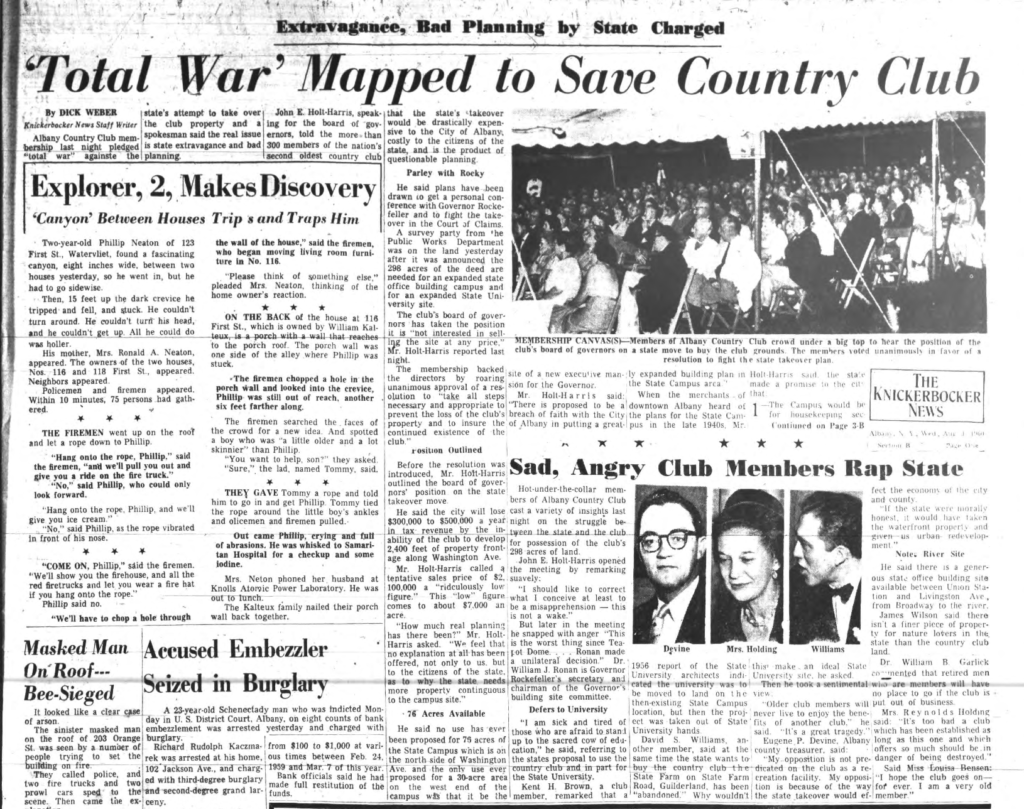
The Albany Country Club used to actually be in Albany, for many years, until it was chased out for the purpose of higher education.
A Knickerbocker News, November 4, 1950, article noting that the Albany Country Club was celebrating its 60th anniversary says that the Club received its corporate seal in 1890 as the Albany Hunt and Country Club, which was originally located in a tavern on the Sand Plains along “the old Schenectady Post Rd.” That was essentially on the property that is now SUNY Albany. The club’s website provides a history that says the Country Club and the Country Hunt Club were different things that joined together, and that to reach the “tumbled down tavern” one had to go from Manning Boulevard to a continuation of Washington Avenue, “and then by a trail to the grounds.”
The Knick News article says that “At that time hunting was the main function, and hounds were kept in a wired-off yard. The early calendar included a fox hunt on Thanksgiving and teas each Saturday afternoon, at which members took turns providing the food.” In 1895, a farm called Wellhurst, directly south of the original location, was purchased, and newfangled activities like ice skating, hockey, tennis and even golf took precedence. “Golf was ridiculed at first and the few who took up the game were called ‘British cranks.'”
But by 1960 the State University was looking for a place to create a new Albany campus, and it settled on the Albany Country Club property, which it quickly moved to acquire by eminent domain. A 1960 column by sportswriter Ben Danforth bemoaned the state’s action in this case, saying it was counter to the State’s advocacy of bigger and better recreation areas. “To take one of these clubs off the map would leave several hundred people without summer facilities and many of the community’s leading professional and business men without a place to golf. That might bring about a serious situation.”
Right after the State announced its intention to purchase the club property, the club’s board said they weren’t willing to sell at any price, and called the offer of $7,000 per acre “ridiculously low.”
An April 1962 article in the Knick News tells that Robert Trent Jones (“currently engaged in redesigning the Maryland course that was the favorite of former President Eisenhower”) was called as a witness in the $5.3 million suit in the Court of Claims; the club had rejected the state’s offer of $2.1 million for the property. Jones regarded the site as outstanding for golf, and that it offered isolation while being near downtown. “Players felt as if they were in the Adirondacks,” he testified. Another witness for the club, 1950 RPI architecture graduate Jerome L. Smith Jr., testified that only 50 to 60 acres of the property, fronting on Washington and Western Avenues and Fuller Road, were excess land that could be put to commercial use. He increased his estimate to 97 acres while on the stand, but the judge in the case said that anticipated profits from the sale or lease of surplus acreage could not be used as the basis of damages against the state. (Later, “highest and best use” would apply.) The club’s demand was eventually reduced to just over $4 million. That court action was still under way when the State University ordered the club to vacate the premises by Jan. 12, 1962, and the club, acceding to inevitability, found a site in Guilderland where it resides today. For a time the club was housed in “the old Klopfer place,” while their new clubhouse and course were constructed off Wormer Road. In the meantime, tremendous work went into leveling the undulating site for the new college campus into the uniform tabletop it is today.
